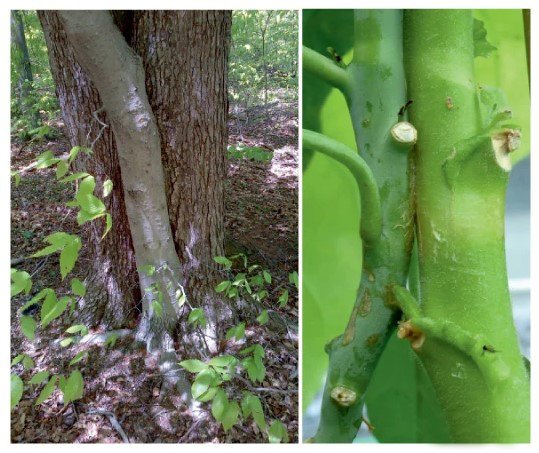Chloroplasts on the move

A natural stem graft between a beech (front) and a maple (back) in a forest near Monroe, New Jersey (left picture), and an similar stem graft between two tobacco plants (right) in the greenhouse.
© MPI-MP, Nature 511
How different plants can share their genetic material with each other.
The genetic material is well protected in the nucleus of cells and stores all the information that forms an organism. For example, information about the size or flower color is predefined here. In addition, cells contain small organelles that contain their own genetic material, including chloroplasts and mitochondria. But is the genetic material actually permanently stored within one cell? No! As known, the genetic material can migrate from cell to cell and thus even be exchanged between different organisms. Researchers at the Max Planck Institute of Molecular Plant Physiology have now been able to use new experimental approaches to show for the first time how the genetic material travels.
The transfer of genetic material occurs quite frequently in plants. This can either result in a new combination of the genetic material, or alternatively the recipient cell can establish both genetic variants in parallel. This union of two different genomes, called allopolyploidization, is very interesting in evolutionary terms, as it leads to the formation of new plant species and is widespread in many plant groups. Many important crops, such as bread and durum wheat, oats, cotton, canola, coffee, and tobacco have such combined genomes from at least two crossed species.
In order to understand the mechanisms of genome transfer from cell to cell, the researchers led by Ralph Bock at MPI-MP conducted experiments with tobacco plants using grafting, which is commonly used in agriculture. Here, two different tobacco plants were grafted onto each other and the cells of the junction were observed microscopically in real time. To differentiate between the genome of nucleus and plastids, fluorescent reporter proteins were integrated and expressed from both genomes and the researchers used a trick using a specialization of the chloroplasts.
In the plastids, a gene is integrated by transformation that encodes a chloroplast-specific fluorescence protein, which is produced exclusively in plastids and cannot leave them. This creates an absolutely specific and stable label for the plastids.
After a short time, the two partners grow together at the graft junction, resulting in a physiological connection between the two plants. “We were able to observe that genome transfer from cell to cell occurs in both directions with high frequency at this site”, explains Dr. Alexander Hertle, first author of the study.
Using a new experimental setup, the researchers were able to observe structural changes in the cell walls in the wound tissue of the graft site. “The cell walls formed protrusions, creating junctions between the two partners. The size of those created pores allows the migration of an entire plastid. Therefore, the genome does not migrate freely, but encapsulated from cell to cell,” Hertle continues. However, to actually make this possible, the plastids have to shrink and become mobile. These rod-shaped plastids are equal to an amoeba and grow back to normal size after transfer into the target tissue.
The researchers have thus uncovered a new pathway for intercellular exchange of very large cell structures, which may also be used by parasitic plants, such as mistletoe, to carry out gene exchange with their host. In addition, it now needs to be clarified whether mitochondria and the nuclear genome also use similar transfer mechanisms.
Wissenschaftliche Ansprechpartner:
Dr. Alexander P. Hertle
Max Planck Institute of Molecular Plant Physiology
Tel. 0331/567 8618
hertle@mpimp-golm.mpg.de
Dr. Ulrike Glaubitz
Press and public relations
Max Planck Institute of Molecular Plant Physiology
Tel. 0331/567 8275
glaubitz@mpimp-golm.mpg.de
http://www.mpimp-golm.mpg.de
Originalpublikation:
Alexander P. Hertle, Benedikt Haberl, Ralph Bock
Horizontal genome transfer by cell-to-cell travel of whole organelles
Science Advances, 01.01.2021, doi: 10.1126/sciadv.abd8215
Weitere Informationen:
https://www.mpimp-golm.mpg.de/2585103/news_publication_16235045_transferred?c=62…
Media Contact
All latest news from the category: Life Sciences and Chemistry
Articles and reports from the Life Sciences and chemistry area deal with applied and basic research into modern biology, chemistry and human medicine.
Valuable information can be found on a range of life sciences fields including bacteriology, biochemistry, bionics, bioinformatics, biophysics, biotechnology, genetics, geobotany, human biology, marine biology, microbiology, molecular biology, cellular biology, zoology, bioinorganic chemistry, microchemistry and environmental chemistry.
Newest articles

Bringing bio-inspired robots to life
Nebraska researcher Eric Markvicka gets NSF CAREER Award to pursue manufacture of novel materials for soft robotics and stretchable electronics. Engineers are increasingly eager to develop robots that mimic the…

Bella moths use poison to attract mates
Scientists are closer to finding out how. Pyrrolizidine alkaloids are as bitter and toxic as they are hard to pronounce. They’re produced by several different types of plants and are…

AI tool creates ‘synthetic’ images of cells
…for enhanced microscopy analysis. Observing individual cells through microscopes can reveal a range of important cell biological phenomena that frequently play a role in human diseases, but the process of…





















